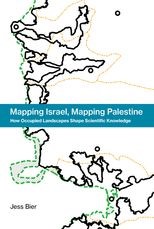Mapping Israel, Mapping Palestine: How Occupied Landscapes Shape Scientific Knowledge
Mapping Israel, Mapping Palestine: How Occupied Landscapes Shape Scientific Knowledge
Cite
Abstract
Mapping Israel, Mapping Palestine is an analysis of the ways that segregated landscapes have shaped digital cartography in Jerusalem and the West Bank since 1967. Extending work on how technology is socially constructed, it investigates the ways that knowledge is geographically produced. Technoscientific practices are situated in landscapes that are at once both social and material, and this influences the content of digital technology in sometimes unpredictable ways. Therefore it is necessary to reflexively engage with materiality and space in order to enable more diverse forms of knowledge. Maps are an iconic symbol of modernity, and they have been central to debates over the future of Palestine and Israel. This has only intensified as Geographic Information Science (GIS) mapmaking has led to increasingly minute forms of surveillance and control. Intended to display objective facts, maps inspire extensive discussions. However, the framing of these discussions cannot be divorced from the participants’ asymmetrical mobilities within the very terrains that they seek to portray. Therefore it is essential to investigate how Palestinian, Israeli, and international cartographers are unevenly affected by the segregated landscapes which their technologies have helped to create. Mapping Israel, Mapping Palestine addresses these important issues by bringing together the disciplines of critical geography, postcolonial theory, and science and technology studies (STS). It presents an analysis of the maps and mapmaking practices that result when diverse cartographers chart the same landscapes that so condition their movement. It investigates the myriad ways that the segregated landscapes of the Israeli occupation shape knowledge about the occupation.
-
Front Matter
-
1
Where Cartographies Collide
-
2
The Materiality of Theory
-
3
Removing Borders, Erasing Palestinians: Israeli Population Maps after 1967
-
4
The Colonizer in the Computer: Stasis and International Control in PA Maps
-
5
Validating Segregated Observers: Mapping West Bank Settlements from Without and Within
-
6
The Geographic Production of Knowledge
-
End Matter
Sign in
Personal account
- Sign in with email/username & password
- Get email alerts
- Save searches
- Purchase content
- Activate your purchase/trial code
Institutional access
-
Sign in through your institution
- Sign in with a library card Sign in with username/password Recommend to your librarian
Institutional account management
Sign in as administratorPurchase
Our books are available by subscription or purchase to libraries and institutions.
Purchasing information| Month: | Total Views: |
|---|---|
| December 2022 | 2 |
| December 2022 | 3 |
| December 2022 | 6 |
| December 2022 | 6 |
| December 2022 | 5 |
| December 2022 | 3 |
| June 2023 | 2 |
| July 2023 | 3 |
| July 2023 | 3 |
| October 2023 | 2 |
| October 2023 | 1 |
| October 2023 | 1 |
| October 2023 | 5 |
| November 2023 | 1 |
| November 2023 | 1 |
| November 2023 | 4 |
| November 2023 | 2 |
| January 2024 | 1 |
| February 2024 | 2 |
| February 2024 | 3 |
| February 2024 | 9 |
| February 2024 | 3 |



Get help with access
Institutional access
Access to content on Oxford Academic is often provided through institutional subscriptions and purchases. If you are a member of an institution with an active account, you may be able to access content in one of the following ways:
IP based access
Typically, access is provided across an institutional network to a range of IP addresses. This authentication occurs automatically, and it is not possible to sign out of an IP authenticated account.
Sign in through your institution
Choose this option to get remote access when outside your institution. Shibboleth/Open Athens technology is used to provide single sign-on between your institution’s website and Oxford Academic.
If your institution is not listed or you cannot sign in to your institution’s website, please contact your librarian or administrator.
Sign in with a library card
Enter your library card number to sign in. If you cannot sign in, please contact your librarian.
Society Members
Society member access to a journal is achieved in one of the following ways:
Sign in through society site
Many societies offer single sign-on between the society website and Oxford Academic. If you see ‘Sign in through society site’ in the sign in pane within a journal:
If you do not have a society account or have forgotten your username or password, please contact your society.
Sign in using a personal account
Some societies use Oxford Academic personal accounts to provide access to their members. See below.
Personal account
A personal account can be used to get email alerts, save searches, purchase content, and activate subscriptions.
Some societies use Oxford Academic personal accounts to provide access to their members.
Viewing your signed in accounts
Click the account icon in the top right to:
Signed in but can't access content
Oxford Academic is home to a wide variety of products. The institutional subscription may not cover the content that you are trying to access. If you believe you should have access to that content, please contact your librarian.
Institutional account management
For librarians and administrators, your personal account also provides access to institutional account management. Here you will find options to view and activate subscriptions, manage institutional settings and access options, access usage statistics, and more.